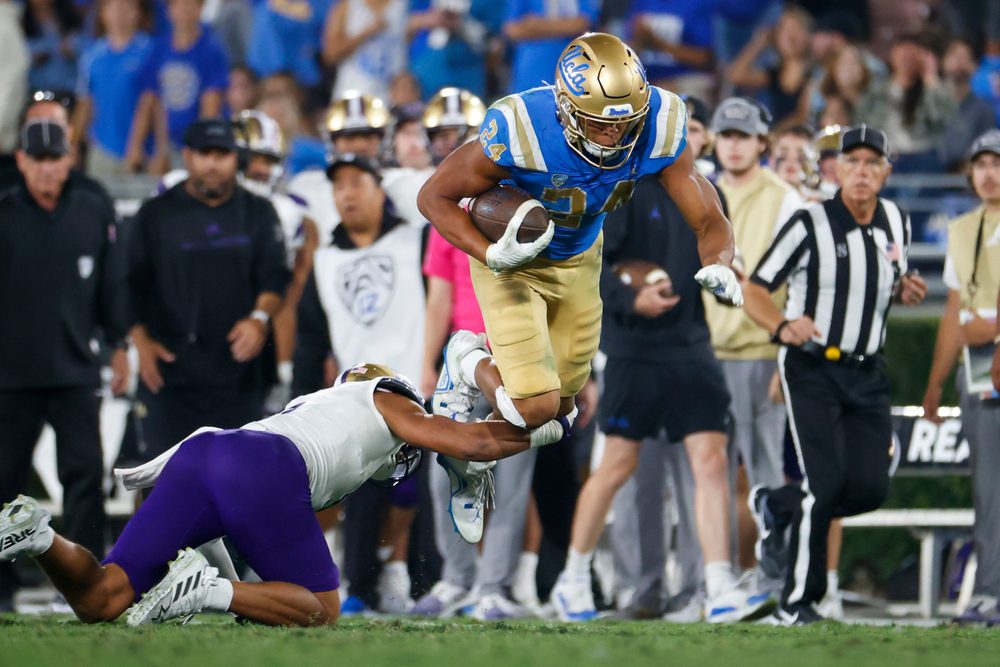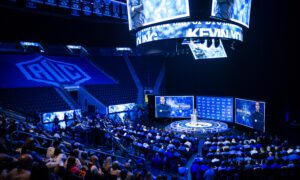
This article is brought to you by Underdog Fantasy. Use the code ESPN960 when you sign up to get your first deposit of up to $100 doubled. If you enjoyed this article please support our sponsors, we aren’t able to keep bringing Cougar Sports insider knowledge without our sponsors. Thank You!
Link to Part 2: Brand/Fan Base Value
By Krindorr and Jeff Fuller
For all the reasonable and important discussion of markets, brands, attendance, and on-field success, the one metric that matters most to network (or streaming) executives is how many people watch the games. Those other factors can provide warning signs for a pending increase or decrease in viewership, but viewership is where the money is made.
Unfortunately, viewership is also one of the most difficult factors to assess, especially without the in-depth data available to network and conference insiders – and with so many armchair statisticians out to support a predefined conclusion. So let’s take a brief foray into how the sausage is made.
That said, if you just want to get to the results, you can skip this next section – feel free to scroll down to where they start and nobody will blame you.
Consider the following claims:
- Over the last 5 non-COVID years, regular-season games involving Big 12 teams have drawn an average of 1.27M viewers. The average regular-season game with a PAC participant only drew 967k – putting the Big 12 32% ahead of the PAC in viewership. Clearly the Big 12 is MUCH stronger.
- Over the last 5 non-COVID years, regular-season games of the remaining Big 12 members have drawn an average of 1.07M viewers, compared to 1.58M for the remaining PAC teams. That puts the PAC 48% ahead of the Big 12. Clearly the PAC is much stronger.
- Over the last 5 non-COVID years, the average viewership of games involving future Big 12 members is 646k. The average viewership of games involving the remaining PAC10+SDSU/SMU is 645k. Clearly the two conferences are basically equal.
So, which statement is true? The answer is … all of them, depending on how you parse the data. The PAC average can easily be 970k or 1.6M or 645k if it suits an agenda.
How? Statement 1 includes every regular-season game played (including Texas, Oklahoma, USC and UCLA) while counting viewership as zero for every game where ratings are unavailable (see Zach Miller’s work for an analysis that makes this assumption). Statement 2 includes only games which received ratings, making it a much smaller sample size for the PAC. It also excludes every game which involved Texas, Oklahoma, USC or UCLA. Statement 3 reverts back to including unrated games as zero viewers, but now adds BYU, Cincinnati, Houston, and UCF…as well as the two most widely-discussed potential PAC additions.
So in an effort to provide an unbiased review, we have to determine how to treat different networks, timeslots and opponents, as well as how to handle games for which ratings aren’t available. For the duration of this article, we’ll be using the following assumptions
- Team viewership will be assessed based on their viewership score. There’s some math behind this, but it basically boils down to a way to bridge the gap between no credit for unrated games and blindly assuming that those games (often weaker) would draw the same as the games for which we do have data – neither of which is correct. Viewership score serves as a mathematical estimate of where the average viewership would be if every game were televised.
- TV networks and slots will generally be ignored. This seems counterintuitive, given the clearly huge importance of networks and timeslots. Wyoming would clearly draw more if every game were on FOX at Noon. Alabama would draw fewer viewers than they do now if every game were on FS2 at 11:30 PM. However in this case, we’re basically trusting the TV executives to have reasons and logic behind their decision. There’s a reason Wyoming isn’t in the prime slot and Alabama isn’t relegated to late night on obscure channels. Choosing to put a program in a prime viewing window is, in itself, a strong reflection of their assessed viewership value. Similarly, choosing to not air a game on a rated channel often reflects an assessment of that program’s drawing power.
- Similarly, opponent will be ignored. Viewership Score, by its nature, already mitigates the impact of outliers and on a long enough time-scale, the average past opponent becomes fairly in-line with the average future opponent. It’s worth noting that this simplification may result in new P5 additions being slightly underrated as their opponent profile actually will change.
***Welcome back – we’re done talking about methods and processes now – onto the interesting things
So, bottom line question – which conference draws better without their marquee names?
At first glance, the answer appears to be the PAC. The Big 12 was ahead, but losing those Texas and Oklahoma games hurt the Big 12 substantially more than losing the USC and UCLA games hurt the PAC.
But that’s not all there is to the story. If it were, the PAC would likely already have the TV deal they’re looking for. The remaining PAC teams HAVE drawn better – but remember that media rights deals are looking at the future and not at the past. In this case we need to not only consider the trajectory but also price in a level of uncertainty.
Consider the below list of the highest 27 viewed Big 12 and PAC games (not involving departing members) over the last 3 (non-COVID) years
While the PAC numbers for the recent past clearly ARE higher (partially but not entirely due to having more teams and therefore more games), there’s a few dangerous warning signs for the PAC hidden in this chart
Firstly, the PAC is dangerously reliant on Oregon for any sort of strong viewership.
Nine of the 10 highest viewed PAC games involve Oregon. Taking it a step further, 19 of the 20 highest viewed PAC games involve either Oregon or Washington. Only one PAC game has topped 1.6M viewers in the last 3 years without involving USC, UCLA, Oregon or Washington.
This creates two issues. First, the ongoing concern about Oregon and/or Washington departing to the Big 10 leaves media partners with uncertainty, which depresses the market. But the larger issue is that, even with Oregon in the PAC fold, there’s a strong demand for first choice of games…but not much interest in getting second choice (or lower). This matches reports that ESPN and Amazon have both expressed interest in one game a week, but don’t really care for the rest of the package.
This issue is then further exacerbated by the weak potential expansion options for the PAC. Going back to the first chart, the Big 12 was able to bring in high viewership teams that were basically on par with their remaining members (despite the lower-profile nature of playing outside the P5). The PAC lacks those same options. For a conference already struggling to get interest beyond the game of the week, San Diego St and SMU aren’t game-changers.
Secondly (and most importantly) the PAC is on a dangerous trajectory.
When considering the 27 highest-viewed games across 3 years, you’d expect there to generally be the same number from each year – Nine (which is why 27 was chosen instead of 25)
But of the PAC’s top 27 games, 12 were in 2019, 10 in 2021 and only 5 in 2022. 12 -> 10 -> 5…that’s not a good trend.
By comparison, the Big 12 is rising with nearly half (13/27) of their highest-viewed games (non-OUT category) in the last year.
This second point is evident both in the big conference-level picture and at the individual program level.
Looking at composite viewership score by conference over the last two years, we again see the PAC (USC/UCLA games excluded) slightly ahead of the Big 12 (Texas/Oklahoma games excluded). Both are close to the ACC and miles behind the Big Ten and SEC, as would be expected.
It’s certainly not breaking any news by stating those two conferences are well ahead of the other 3, though it is worth noting the remaining 10 PAC teams have been just a nose ahead of the remaining 8 Big 12 teams. But the really interesting thing is looking at the trajectory (again, all games involving teams changing conferences are excluded from this metric)
As a whole, the PAC is the major conference with BY FAR the largest viewership drop in that time frame, with the composite conference viewership score (for games not involving USC or UCLA) dropping by 14.5% in that interval.
By comparison, the composite conference viewership score for the 8 remaining Big 12 teams (in games not involving Texas or Oklahoma)? It improved 29.9% in the same time frame, easily the best of any major conference. Certainly it’s easier for the Big 12 to improve from their more humble numbers than it is for the SEC or B1G…but 30% is impressive no matter who you are.
Drilling down to the individual teams shows the same story
Just at first glance, there’s a LOT of blue (PAC) on the left, declining side of that chart. And a LOT of red (Big 12) on the right, growth side.
Looking individually at the remaining PAC teams, only 4/10 had a higher viewership score in the 2021-2022 seasons than they had in 2018-2019. Those include Oregon St and Cal (who improved on a baseline of basically nothing), Oregon (who is actively attempting to leave the conference) and Utah.
While it’s worth noting that San Diego St has also seen a strong uptick in percent viewership, the initial viewership (like that of Cal, Kansas and Oregon St) is so low as to make the large percent increase less meaningful than first appearances would indicate. On the other hand SMU not only draws poorly, but is also on a downward trajectory, drawing even less than they previously had. While SDSU has some merit, any plan which sees SMU as the savior of the PAC is severely misguided.
Unfortunately for the PAC, there’s simply no other better option available after the Big 12 took BYU and Cincinnati (both with high viewership and improving), UCF (coming down, but still fairly high viewership) and Houston (frankly more an upside bet on population than based on viewership or viewership trends). But the conference is in desperate need of reinforcements.
2022 marked the first time the remaining 8 Big 12 teams had stronger viewership than the remaining 10 PAC teams. But with one conference (the Big 12) increasing viewership 30% over the last 3 years, and the other (PAC) decreasing viewership metrics by 15%, is it any wonder that networks would rather hitch themselves to the Big 12?
If the media rights deal was for the recent past (or even arguably for the right now), the PAC would have an argument to be ahead of or equal to the Big 12. But in paying for the future, network executives have to consider trajectory. And right now, the two conferences are equal in viewership (or very nearly so)…but headed strongly in opposite directions
__________________________________________________________________
**NOTE: As a bonus, those interested in the viewership score of teams not shown here can feel free to peruse the below table or at this link
1 Viewership Score is calculated using 3 values, the average of all games, the average of all RATED games, and the median of all RATED games. By taking the harmonic mean of the RATED game average and the RATED game median, we can reduce the impact of outlier games (for example, when a team plays Alabama or Ohio St). We then again take the harmonic mean of that resulting value with the average of all games, accounting for the many games which were not aired.
2 TV viewership is influenced by a several factors: including time slot, channel, who the opponent is, is one or are both teams ranked, how competitive is the matchup is expected to be, how much the networks/talk shows have promoted the game, how close/exciting the game ends up being, what other games are going on at the same time, and what the lead-in games/programs are. You could put Bishop Sycamore vs The Little Sisters of the Poor in a prime Saturday afternoon ABC spot following the Red River Rivalry and it would garner 1-2 million viewers. Many teams have been able to garner high average viewership numbers because they routinely play against the bigger brands and their games vs lesser brands are removed from the viewership stats to bring down their “average viewership.”. Case in point is Oregon State, which only had 40 rated games over a 9 year period (2013-21), but averaged 1.1M viewers per game. Playing Oregon and Washington accounted for most of those games and the Beaver’s solid average viewership number… but is it correct to give them the credit for the viewership when it was more about who they were playing?















